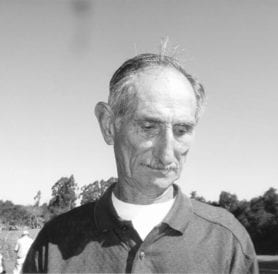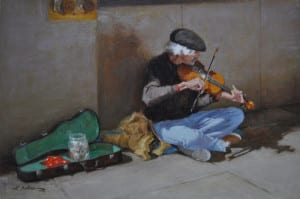
We all want to achieve at a very high level and create the next great piece of art. Recent psychological studies have determined happier people are generally more successful.
“Happiness is the meaning and purpose of life, the whole aim and end of human existence” -Aristotle
It bears to reason that we all will paint more often and better if we are inspired, motivated and happy.
My favorite two questions for my workshop artists are:
- What do you love to paint? And
- How would you love for your paintings to look?
I am fortunate to get to teach pleasant artists in my workshops, thanks to all of you. Over the years it has become obvious the number one reason for people not achieving better paintings faster or even painting at their very best is they get discouraged, blame themselves or lose their bliss along the way.

When you are unmotivated, don’t ask yourself what the world needs or what would sell, “ask yourself what makes you come alive and then go do that. Because what the world needs is people who have come alive” – Dr. Howard Thurman
So why not learn from a few notables who have achieved extraordinary success.
I love the comments of, I believe, Everett Raymond Kinstler in one of his videos:
“I start out in this way thinking, ‘this will be the greatest painting of this subject matter ever painted.’ Later in the process I think, ‘this will be the greatest painting of this subject matter I ever painted,’ and finally I think, ‘Hell! I hope I can save this painting!’ [paraphrased]”
Doesn’t this help you chuckle at yourself and free you?
When Richard Schmidt was asked he stated,
“I just paint. I don’t consider my place in history. And don’t blame yourself when something goes wrong. Just learn what you did wrong and don’t do it again. [paraphrased]”
I appreciate Scott Christensen for his help along the way and his piece of advice: “always paint for yourself.” We should always remember this when we are watching others sell a certain genre or style that does not ring true to who we really are.

Most representational artists know strong abstract design underlies every piece of representational art, and values are the bones. So interesting shapes and design, held in unity by values, are the backbones of all good paintings. The process for being accepted in OPA shows is very fair and when looking at 2000 or so paintings it becomes real obvious how much the above statement is true.
At higher levels most artists are painting spots of color and value and not objects. Painters say a great painting is greater than its sum of its’ parts. The only way that can be achieved is to paint from the heart, for all really great art is created from the heart.

Perhaps if we all stay more motivated we will all create better art and most importantly enjoy the process more. This is always something I confess to have to be aware of — because as a past lawyer that only focused on results, and now a reformed artist — nothing is clearer to me than that, if the process is enjoyable, I will paint more often and better.
I find that artists are generally humble, share freely and are kind to one another. I consider myself lucky to have found such a great group of people and friends. I think it important that we, as artists, always share what we know. It is often so hard to paint good paintings, so we all need the fresh eyes and keen advice of other artists — as our friends and colleagues. I encourage you to celebrate the awards and excellent paintings of your fellow artists — that’s what makes being an artist really enjoyable. Hope to see you soon, whether in nature or at a show.
 Every portrait painting is the result of a series of steps. Some artists have fewer steps than others, and most artists are eager to grab their paints and dive right into the color process. But those who simply pose their model and start painting are taking a lot of chances, such as improperly placing the model on the canvas or discovering a more interesting pose once you’ve already begun. After many hours of your hard work and your model’s patient posing, you don’t want to wipe it all off and start over again.
Every portrait painting is the result of a series of steps. Some artists have fewer steps than others, and most artists are eager to grab their paints and dive right into the color process. But those who simply pose their model and start painting are taking a lot of chances, such as improperly placing the model on the canvas or discovering a more interesting pose once you’ve already begun. After many hours of your hard work and your model’s patient posing, you don’t want to wipe it all off and start over again. This kind of familiarity also pays off because with a live model, no matter how good a model he or she is, your subject is frequently changing. There are many muscles in the human head, more than in any other part of the body, and nearly all of them move when the expression changes on the subject’s face. If you can learn some thing about what muscles made the expression you want, then you can compensate for subtle changes (A smile, for instance, consists of much more than just upturned corners of the mouth.)
This kind of familiarity also pays off because with a live model, no matter how good a model he or she is, your subject is frequently changing. There are many muscles in the human head, more than in any other part of the body, and nearly all of them move when the expression changes on the subject’s face. If you can learn some thing about what muscles made the expression you want, then you can compensate for subtle changes (A smile, for instance, consists of much more than just upturned corners of the mouth.) Portrait Pointer: when you can’t find a model who is willing to sit for several hours, go for photography. Be ready with your camera when a great face comes your way. Just remember, don’t just copy the photo, study the bone structure and value patterns the same as you would when using a live model. Measuring is very necessary. Remember, every skull is different. Don’t generalize. Drawing is not only necessary to portraiture but a beautiful and fun form of art.
Portrait Pointer: when you can’t find a model who is willing to sit for several hours, go for photography. Be ready with your camera when a great face comes your way. Just remember, don’t just copy the photo, study the bone structure and value patterns the same as you would when using a live model. Measuring is very necessary. Remember, every skull is different. Don’t generalize. Drawing is not only necessary to portraiture but a beautiful and fun form of art.







